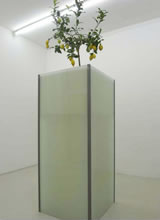SATOSHI HIROSE, "Microcosm"

The solo exhibition by Satoshi Hirose, Microcosm was held at the Umberto Di Marino Arte Contemporanea Gallery in Napoli over a period of 2 months from March 6 to May 6. TAKASAGO offered lemon oil for his work.
The Japanese artist analyses the new lifestyles of our days highlighting their complexity and contradictions; the metaphor of the journey becomes the means to move through different cultures and traditions. The changes brought about by the globalisation often causes in the man a loss of identity because of the continuous exchange of information with the world.
This process, favoured by the increase of the new technologies, paves the way for a social adaptivity that characterises our days, but with conditions always different. The artist processes these preambles in a refined way coming to a personal aesthetics of the lightness and a deeper reflection.
On the occasion of the project intentionally conceived for the Umberto Di Marino Arte Contemporanea Gallery, the show is concentrated on some ideas that give us a unique interpretation of fragments of the reality coming from contests apparently different.
Thanks to the frequent use of the analogy and metonymy the show appears to be a small microcosm where each element is connected with the works, just as it happens in the everyday relationship between the man and the others.
Taking Deleuze's texts upon Spinoza's theory as a starting point, Satoshi Hirose points out that the small particles of the atom merge creating the innumerable possibilities of the substance with combinations always different. In the same way, people merge their lives with a lot of different new cultures that exceed their physical and mental limits.
To cross the spaces reducing the distance offers a new interpretation of the things, and this process influences the relationship with his own body and his own way of perception, too.
The idea that the movement measures the places through the interaction of the man with what surrounds him is peculiar to the original culture and represents the starting point for the work placed in the first room, thanks to the strong scent of lemons coming from a small tree, attracts immediately the viewer's attention. The tree is embedded in an unusual glass shrine and represents the link with other works that have already been on display in some famous foreign museums.